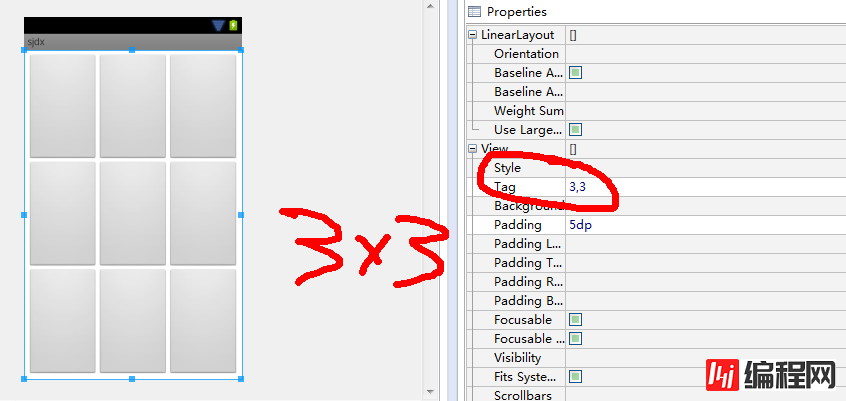本文实例讲述了Android实现九宫格(GridView中各项平分空间)的方法。分享给大家供大家参考。具体如下: 项目需要做一个九宫格(也不一定是9的,4宫格、16宫格、4x3
本文实例讲述了Android实现九宫格(GridView中各项平分空间)的方法。分享给大家供大家参考。具体如下:
项目需要做一个九宫格(也不一定是9的,4宫格、16宫格、4x3宫格。。。),封了 一个宫格,它能够根据为它分配的空间来自动的调节宫中各项的尺寸。
从TableLayout集成来的,因此如果你直接在设计器上使用该封装的话需要把它自动加进去的那几个TableRow删除一下。
类名为AdvancedGridView,代码如下:
import android.content.Context;
import android.util.AttributeSet;
import android.view.View;
import android.widget.BaseAdapter;
import android.widget.Button;
import android.widget.TableLayout;
import android.widget.TableRow;
public class AdvancedGridView extends TableLayout {
// private static final String tag = "AdvancedGridView";
private int rowNum = 0; // row number
private int colNum = 0; // col number
private BaseAdapter adapter = null;
private Context context = null;
public AdvancedGridView(Context context) {
super(context);
initThis(context, null);
}
public AdvancedGridView(Context context, AttributeSet attrs) {
super(context, attrs);
initThis(context, attrs);
}
private void initThis(Context context, AttributeSet attrs) {
this.context = context;
if (this.getTag() != null) {
String atb = (String) this.getTag();
int ix = atb.indexOf(',');
if (ix > 0) {
rowNum = Integer.parseInt(atb.substring(0, ix));
colNum = Integer.parseInt(atb.substring(ix+1, atb.length()));
}
}
if (rowNum <= 0)
rowNum = 3;
if (colNum <= 0)
colNum = 3;
if(this.isInEditMode()){
this.removeAllViews();
for(int y=0; y<rowNum; ++y){
TableRow row = new TableRow(context);
row.setLayoutParams(new LayoutParams(LayoutParams.FILL_PARENT, LayoutParams.FILL_PARENT, 1.0f));
for(int x=0; x<colNum; ++x){
View button = new Button(context);
row.addView(button, new TableRow.LayoutParams (LayoutParams.MATCH_PARENT, LayoutParams.MATCH_PARENT, 1.0f));
}
this.addView(row);
}
}
}
public BaseAdapter getAdapter() {
return adapter;
}
public void setAdapter(BaseAdapter adapter) {
if(adapter != null){
if(adapter.getCount() < this.rowNum*this.colNum){
throw new IllegalArgumentException("The view count of adapter is less than this gridview's items");
}
this.removeAllViews();
for(int y=0; y<rowNum; ++y){
TableRow row = new TableRow(context);
row.setLayoutParams(new LayoutParams(LayoutParams.FILL_PARENT, LayoutParams.FILL_PARENT, 1.0f));
for(int x=0; x<colNum; ++x){
View view = adapter.getView(y*colNum+x, this, row);
row.addView(view, new TableRow.LayoutParams (LayoutParams.MATCH_PARENT, LayoutParams.MATCH_PARENT, 1.0f));
}
this.addView(row);
}
}
this.adapter = adapter;
}
public int getRowNum() {
return rowNum;
}
public void setRowNum(int rowNum) {
this.rowNum = rowNum;
}
public int getColNum() {
return colNum;
}
public void setColNum(int colNum) {
this.colNum = colNum;
}
}
如果你想在设计阶段就看到宫格效果的话,你可以在该空间的Tag属性上设置行列个数。比如我想看到3x3的宫格样子的话就设置成"3,3",如下图,当然你也可以在代码中使用setRowNum()和setColNum()来进行设置,但是请在设置适配器前调用这两个方法。

希望本文所述对大家的Android程序设计有所帮助。
您可能感兴趣的文章:Android 九宫格的实现方法android 九宫格滑动解锁开机实例源码学习Android打造流畅九宫格抽奖活动效果轻松实现Android自定义九宫格图案解锁Android开发之实现GridView支付宝九宫格Android编程之九宫格实现方法实例分析Android实现九宫格解锁的方法Android学习教程之九宫格图片展示(13)Android布局案例之人人android九宫格android实现九宫格程序
--结束END--
本文标题: Android实现九宫格(GridView中各项平分空间)的方法
本文链接: https://lsjlt.com/news/26679.html(转载时请注明来源链接)
有问题或投稿请发送至: 邮箱/279061341@qq.com QQ/279061341
2024-01-21
2023-10-28
2023-10-28
2023-10-27
2023-10-27
2023-10-27
2023-10-27
回答
回答
回答
回答
回答
回答
回答
回答
回答
回答
0